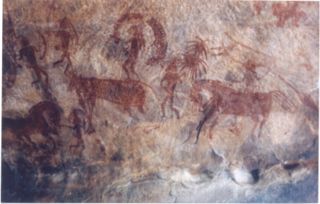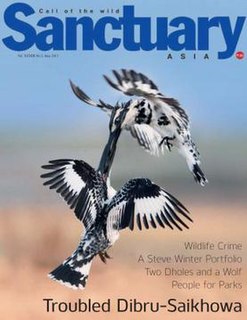 W
WThe environment of India comprises some of the world's most biodiverse ecozones. The Deccan Traps, Gangetic Plains and the Himalayas are the major geographical features. The country faces different forms of pollution as its major environmental issue and is more vulnerable to the effects of climate change being a developing nation. India has laws protecting the environment and is one of the countries that signed the Convention on Biological Diversity (CBD) treaty. The Ministry of Environment, Forest and Climate Change and each particular state forest departments plan and implement environmental policies throughout the country.
 W
WBiogeographic classification of India is the division of India according to biogeographic characteristics. Biogeography is the study of the distribution of species (biology), organisms, and ecosystems in geographic space and through geological time. India has a rich heritage of natural diversity. India ranks fourth in Asia and tenth in the world amongst the top 17 mega-diverse countries in the world. India harbours nearly 11% of the world’s floral diversity comprising over 17500 documented flowering plants, 6200 endemic species, 7500 medicinal plants and 246 globally threatened species in only 2.4% of world’s land area. India is also home to four biodiversity hotspots—Andaman & Nicobar Islands, Eastern Himalaya, Indo-Burma region, and the Western Ghats. Hence the importance of biogeographical study of India's natural heritage.
 W
WEcomark or Eco mark is a certification mark issued by the Bureau of Indian Standards to products conforming to a set of standards aimed at the least impact on the ecosystem. The marking scheme was started in 1991. One of the purposes of the mark is increasing awareness among the consumers towards reducing environment impact. The mark is issued to various product categories and the development of standards for more products is in progress.
 W
WGreenathon is a nationwide campaign to save the environment. The main goal is to spread awareness among people in India to sustain the greenery of Mother Nature. It also helps generate money to spread awareness for various social causes. It is sponsored by Toyota.
 W
WNatural history in India has a long heritage with a recorded history going back to the Vedas. Natural history research in early times included the broad fields of palaeontology, zoology and botany. These studies would today be considered under field of ecology but in former times, such research was undertaken mainly by amateurs, often physicians, civil servants and army officers.
 W
WThe National Biodiversity Authority (NBA) is a statutory autonomous body under the Ministry of Environment, Forests and climate change, Government of India established in 2003 to implement the provisions under the Biological Diversity Act, 2002, after India signed Convention on Biological Diversity (CBD) in 1992.
 W
WNatural disasters in India, many of them related to the climate of India, cause massive losses of life and property. Droughts, flash floods, cyclones, avalanches, landslides brought by torrential rains, and snowstorms pose the greatest threats. A natural disaster might be caused by earthquakes, flooding, volcanic eruption, landslides, hurricanes etc. In order to be classified as a disaster, it will need to have a profound environmental effect and/or human loss and frequently incurs a financial loss. Other dangers include frequent summer dust storms, which usually track from north to south; they cause extensive property damage in North India and deposit large amounts of dust and dirt from arid regions. Hail is also common in parts of India, causing severe damage to standing crops such as rice and wheat and many more crops.
 W
WSanctuary Asia is an Indian nature and wildlife conservation magazine founded in 1981 by Bittu Sahgal, its current editor. The magazine expanded in 2015 to become established as a non-profit foundation.